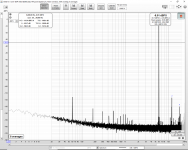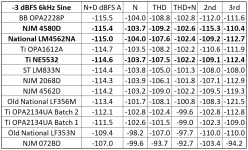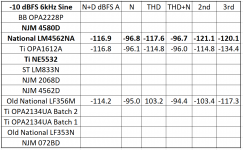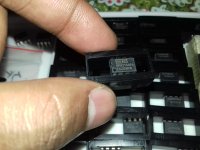I just put NJM 072BD and then LF353N in my PCM1798 DAC. They measure very differently. The LF353N (old National parts) performed amazingly well. The TL072 performs poorly in that application. I put them in the I/V and the filter locations. (Using the BB schematic.)
In order the graphs are NJM 072BD, LF353N, LF356M and LM4562NA.
These are single ended measurements at 6kHz (to make it harder than 1kHz) -3 dBFS. Later I will do balanced measurements with my E-MU 1616m.
Wow! Excellent. As far as i know lf353 has low noise, higher bandwidth and better drive capability compared to tl072 but I didn't expect this, the difference is very apparent. Also Lf356 performed really well. He he...


I was shocked. When LF353 & LF356 were initially mentioned in the thread I was tempted to post. However I am glad that I waited and remembered that I had some from 20 years ago in storage boxes. I dug those out for the measurements and they are surprisingly capable.
They seem perfectly reasonable to use as long as you are happy with the noise levels. The LM4562NA performs really well, as does the OPA1612A. For price to performance ratio some like the LF353 and NJM4580D are bargains. The LM4562NA is really a bargain too considering it has a "fairly" reasonable price and excellent performance. By the way I recommend staying away from NJM4562 as in my measurements it does not compare with LM4562NA. Also I suggest the NJM4580D over the NJM2068D.
I think genuine ones can be bought for reasonable prices from Electronic Components Distributor | JLCPCB & EasyEDA Parts Online store - LCSC.COM (with of course the shipping cost issue.)
Keep in mind that different results can be seen (in terms of performance ranking) depending on the application. The results with my CS4398 DAC output filter (as a test platform) are not the same as with the PCM1798 DAC I/V and output filter (as the test platform). For example, the OPA2134 measures very well with the CS4398 but not with the PCM1798.
They seem perfectly reasonable to use as long as you are happy with the noise levels. The LM4562NA performs really well, as does the OPA1612A. For price to performance ratio some like the LF353 and NJM4580D are bargains. The LM4562NA is really a bargain too considering it has a "fairly" reasonable price and excellent performance. By the way I recommend staying away from NJM4562 as in my measurements it does not compare with LM4562NA. Also I suggest the NJM4580D over the NJM2068D.
I think genuine ones can be bought for reasonable prices from Electronic Components Distributor | JLCPCB & EasyEDA Parts Online store - LCSC.COM (with of course the shipping cost issue.)
Keep in mind that different results can be seen (in terms of performance ranking) depending on the application. The results with my CS4398 DAC output filter (as a test platform) are not the same as with the PCM1798 DAC I/V and output filter (as the test platform). For example, the OPA2134 measures very well with the CS4398 but not with the PCM1798.
Last edited:
I thank you for everything🙂 Lf353/56 are very much available here and with a reasonable price. I already bought a few lf353n(old national circuitry as per datasheet) and now it's time to grab some lf356 😉🙂
...another issue with LM358 is the slew rate. ....
"Another"? Nobody in this thread has said LM358. The LM353 is a very different beast.
Attached is some tabulated data from my PCM1798 DAC. This is still the single ended data. Later I will work on the balanced data.
It is all at 6kHz which makes it harder than 1kHz.
The first is at -3 dBFS. The second is at -10 dBFS.
It is all at 6kHz which makes it harder than 1kHz.
The first is at -3 dBFS. The second is at -10 dBFS.
Attachments
Please note LM4562 often exhibits popcorn noise. Not exactly a secret but I thought to mention it in case to is unknown to you.
I actually don't know much about popcorn noise. I don't have many LM4562 and I don't detect even a hint of any pop-corn popping noise or really any noise when I use the ones I have with my PCM1798. I do like the LM4562NA, perhaps even more than OPA1612A.
How would it affect a typical DAC FFT measurement? Or does one need to look for the sudden up and down step transitions of bi-stable noise with a scope?
What other op-amps (modern, audio) have this issue?
How would it affect a typical DAC FFT measurement? Or does one need to look for the sudden up and down step transitions of bi-stable noise with a scope?
What other op-amps (modern, audio) have this issue?
"Another"? Nobody in this thread has said LM358. The LM353 is a very different beast.
LF353 you mean?
The LM358 is mentioned on the list I posted, because that list is copied from the elephant monitoring thread. It's off topic here because it has no JFETs. The LM4562 is equally off topic.
Last edited:
OP249.... I used that one a lot but thought it was obsolete but they are still in production I see. Coincidentally I just made a list of parts to order and OP1642 is on the list. Glad to read it is a good performer.
Is there any documentation for the claimed popcorn noise...I've been using the LM4652/LME49720 for years and have never had any issues.Please note LM4562 often exhibits popcorn noise. Not exactly a secret but I thought to mention it in case to is unknown to you.
Mike
- Home
- Design & Build
- Parts
- Cheap JFET input op-amp



